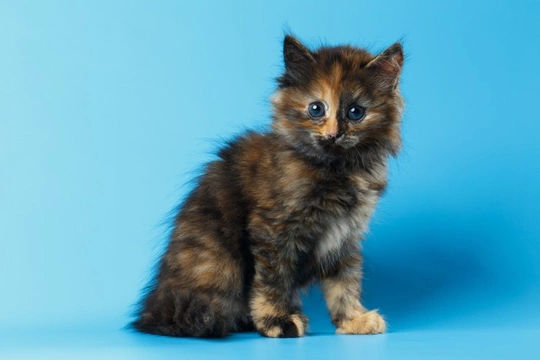
Seven interesting facts about tortoiseshell and calico cats
Both tortoiseshell and calico coloured cats are rather interesting for a lot of reasons, not least that this particular colour trait tends to be seen in female cats only, and of course that these colours and patterns are very pretty and appealing! In this article, we will share seven interesting and informative facts about tortoiseshell and calico cats, to help you to develop a better understanding of the traits of this colourway, and how it occurs. Read on to learn more!
Tortoiseshell and calico colouring
What makes a cat a calico or a tortoiseshell (tortie for short!) comes down to the colour and pattern distribution across their coats. All calico and tortoiseshell cats come in a combination of at least two colours, of which one is not white, or three colours if white is included-the most common three-colour combination is white, ginger, and black or grey, whilst two-colour cats are commonly ginger and black or grey. The distribution of the pattern and amount of each colour in the coat is random, and can vary widely from cat to cat!
The difference between calico and tortoiseshell
First of all, it is worth noting that the terms tortoiseshell and calico are often used interchangeably, particularly in the UK. The term calico is one that is much more widely used in the USA than it is here, where often, the name tortie or tortoiseshell is used for all cats with a three-colour coat.
However, when the names are used correctly, tortoiseshell is the term used to refer to both a two-colour cat for whom one of the colours is not white (normally ginger and black or grey) or a three-coloured cat whose dominant coat colour is black or dark grey, usually with ginger and white.
Calico is the colour name given to a three-colour cat whose dominant colour is white or light grey, accompanied by two other colours, commonly ginger and black or dark grey.
The sex of calico and tortie cats
If you spot a calico or a tortie out and about and want to impress your friends, tell them that the cat is female- you will have a better than 99% chance of being correct!
Whilst male torties and calico cats do exist, they are much rarer, and are usually sterile, and often, have problems with their vision. This comes down to the genetics that lead to the calico and tortie colours, which we will cover below.
The genetics of the colour pattern
The colour distribution and patterning that is calico or tortie comes down to the cat’s genetics. Male cats carry an X and a Y chromosome, whilst females carry two X chromosomes. It is these X chromosomes that carry the data that defines the coat colour of any given cat, and if a female cat carries one X chromosome for a ginger colour the other for a black colour, and lyonization occurs, which is a process by which one of the two colour expressions become inactivated in each of the two X chromosomes, the coat pattern that the cat displays will take on the signature patched or mixed calico or tortie pattern, which is known as mosaic expression.
In order for this to occur, the kitten in question needs to inherit two X chromosomes, and ergo, are female. When a male kitten inherits the calico or tortie pattern, this means that they have inherited not only two X chromosomes, but also one Y (male) chromosome, and this anomalous heredity of three chromosomes is what leads to issues such as sterility in the male tortie or calico cat.
Coat patterning
The amount of each of the three coat colours (or two in some torties) and how the colours are distributed across the coat can vary considerably, even in kittens from the same litter. If no white is involved, or the dominant shade is black or dark grey, this makes a tortie, while if white is the dominant colour, accompanied by ginger and either black or grey, this is a calico.
Calico and tortie tabby cats can also be seen, in which they possess one of the signature tabby coat patterns in combination with their colour mixture.
Naughty torties!
Virtually every cat coat colour has temperament traits assigned to it, rightly or wrongly! Ginger cats are often considered to be dominant, adventurous and scrappy, while torties are often considered to be mischievous, into everything and apt to get themselves into hot water with ease! This has led to the tortoiseshell cat attaining the nickname “naughty tortie,” although like all temperament traits attributed to coat colours, this is simply an old wives#’ tale, rather than a scientific fact!
The temperament of any given tortie or calico cat is apt to be variable, just as is true for any other coat colour that can be found in cats as well!
What breed are they?
The terms calico and tortoiseshell are not breed designations, as some people mistakenly think-they simply refer to the colour and pattern distribution of the cat’s coat.
However, some pedigree breeds permit the tortie or calico colouring as part of the breed standard, including the Abyssinian, British Shorthair, Turkish Angora and Maine Coon.



